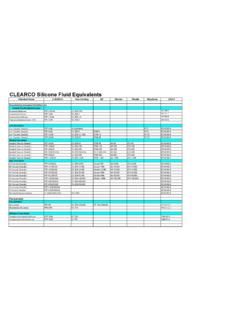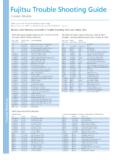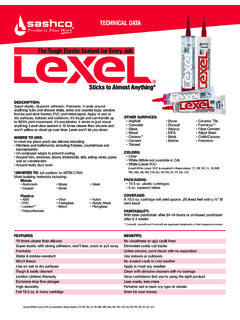Transcription of PROLOGUE DIELECTRIC TESTING REASONS
1 Figure 1: 120 Vac waveform - Wall receptacle power in the TESTING : AC vs. DC part 2 PROLOGUESome questions and concerns have been raised recently regarding the difference between AC andDC DIELECTRIC TESTING . The purpose of this paper is to explain the fundamentals of each test andthe theory behind DIELECTRIC TESTING , and to compare behavior of DIELECTRIC breakdowns in AC andDC TESTING REASONSD ielectric TESTING is intended to check the integrity of the insulation for two basic REASONS :1. The insulation is tested at a voltage much higher than the voltage that the insulation isnormally subjected to, in order to make sure that the insulation is not marginal. This alsooffers an insurance that the insulation is less likely to fail during normal operatingconditions due to aging, deposits of dust, condensation, The insulation is tested at a voltage that represents the type of transient voltage spikesthat occur on voltage systems.
2 Transient voltage spikes on power lines are generally theresult of nearby lightning strikes, but can also occur for other REASONS . In general, thesetransient spikes are a very short duration - the spike lasts for less than 20 microseconds. AC vs. DC VOLTAGE DIELECTRIC TESTING is conducted at a standard reference voltage. For example, the value of 1000 Vac is used. Note that the value of 1000 Vac implies that this is an RMS voltage. RMS standsfor Root Mean Square , which is a way of averaging. The RMS value of a voltage representsthe average value of the voltage over time, and this value is important because standard ACmeters display RMS voltages. The standard value of 120 VAC used in the power grids in the United States is an RMS voltage,and the appropriate way to describe this voltage is 120 Vac, or 120V RMS.
3 Peak voltages of the120 Vac power appearing on the wall plugs in United States homes have a peak value ofapproximately 170 volts, as seen in Figure 1. C:\Program Files\Adobe\Acrobat \Acrobat\plug_ins\OpenAll\Transform\ temp \ Page 2 Figure 2 - 1000 Vac WaveformAC vs. DC DIELECTRIC TEST WAVEFORMSF igure 2 shows an AC waveform with an RMS voltage of approximately 1000 V. Note that thepositive and negative peaks of the voltage are over +1400 Vpeak and positive and negative peaks of a purely sinusoidal waveform are times the RMS valueof the waveform, as proven in calculus and engineering :\Program Files\Adobe\Acrobat \Acrobat\plug_ins\OpenAll\Transform\ temp \ Page 3 Figure 3 - 1414 Vdc waveformDuring DIELECTRIC strength TESTING , the maximum stress on the insulation being tested occurs at thepeak of the AC test voltage.
4 Therefore, if a DC test is conducted, it is appropriate to conduct thetest at a level of times the AC test voltage value, so the value of the DC voltage is equal tothe AC voltage peaks. For a test voltage of 1000 Vac, this would require a DC test voltage of1414 Vdc to represent the same peak voltage, and the same level of stress on the insulation. TheDC test voltage of approximately 1414 Vdc that represents the equivalent test voltage to 1000 Vrms AC is shown in Figure 3. Note that the peak of the test voltage in both Figure 2 and Figure3 is the :\Program Files\Adobe\Acrobat \Acrobat\plug_ins\OpenAll\Transform\ temp \ Page 4 Figure 4: AC Voltage DIELECTRIC BreakdownAC vs. DC DIELECTRIC BREAKDOWN EVALUATIONB ecause the electrical stress on the insulation is highest at the peak of the AC waveform, DIELECTRIC breakdown will occur at the peak of an AC test voltage.
5 Refer to Figure 4, an actualoscilloscope-created picture of an AC voltage DIELECTRIC breakdown. Note that the voltage issmooth as the voltage increases to the peaks, then abruptly breaks down at the peak :\Program Files\Adobe\Acrobat \Acrobat\plug_ins\OpenAll\Transform\ temp \ Page 5 Figure 5 - DC Voltage DIELECTRIC Breakdown: HT5000 Voltage Shutdown EnabledFigure 5 shows the occurrence of a similar DC voltage breakdown. As we saw in Fig. 4, the breakdown occurs at the peak of the AC voltage. From Fig. 2, we sawthat the peak of the AC voltage is a value of times the RMS value of the AC voltage. Therefore, for the AC and DC tests to similarly stress the insulation, it is necessary to conduct theequivalent DC DIELECTRIC withstand test at a value of the peak of the AC test voltage, not the RMSvalue of the AC test voltage.
6 C:\Program Files\Adobe\Acrobat \Acrobat\plug_ins\OpenAll\Transform\ temp \ Page 6It is also important to note how abruptly a DIELECTRIC breakdown occurs. This is shown in Figure6. The same breakdown as shown in Figure 5 has been expanded 50,000 times - the time base onthe scope has been changed from 5 mS (milliseconds) to 100 nS (nanoseconds) in order to zoomin on the breakdown event. Note that the time that it takes for the voltage to drop from the peakvalue to zero volts is 10 nS; approximately a million times faster than the period of the 60 Hz ACtest voltage waveform. Because the breakdown occurs so quickly, and because it occurs at thepeak voltage of the AC waveform, the AC and DC voltages 'appear' exactly the same to thebreakdown; that is, a peak voltage of very long duration.
7 In fact, to restate the above, the peakvoltage of the AC waveform lasts a much longer than the breakdown itself. C:\Program Files\Adobe\Acrobat \Acrobat\plug_ins\OpenAll\Transform\ temp \ Page 7 Figure 6 - AC Breakdown: First 600 nsIn conclusion, we can say that a breakdown occurs so quickly that the difference between an ACtest voltage and a DC test voltage is can be proven by reference to Fig. 7, which is a picture of the same breakdown shown in , except the test was conducted using a DC voltage of times the RMS value of the ACwaveform. Comparison of Figures 6 and 7 show that the behavior of a breakdown between ACand DC conditions is :\Program Files\Adobe\Acrobat \Acrobat\plug_ins\OpenAll\Transform\ temp \ Page 8 Figure 7 - DC Voltage Breakdown: First 600 nsCONCLUSIONIn this paper, I have presented various waveforms to show the following interesting facts aboutdielectric withstand RMS values of waveforms do not properly illustrate their effects on dielectricwithstand TESTING .
8 DIELECTRIC breakdowns occur at the peaks of AC peak voltage of the AC waveform is times the RMS :\Program Files\Adobe\Acrobat \Acrobat\plug_ins\OpenAll\Transform\ temp \ Page peak voltages are equal, DC DIELECTRIC tests will give identical results of AC order for the peak voltages to be equal, the DC voltage used in a DIELECTRIC withstandtest must be times the AC RMS voltage used. , the question of AC vs. DC DIELECTRIC TESTING has nothing to do with the fact thatthe insulation being tested is normally subjected to 120 Vac. A DIELECTRIC breakdown willoccur in nanoseconds. All of these events happen so quickly, that a 60 Hz voltage is stopped in comparison. If the peak voltages of an AC and DC DIELECTRIC withstand testare the same, similar results will be achieved.







